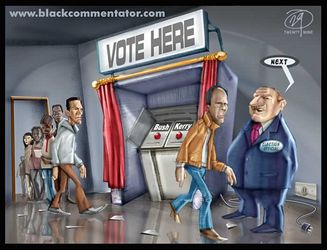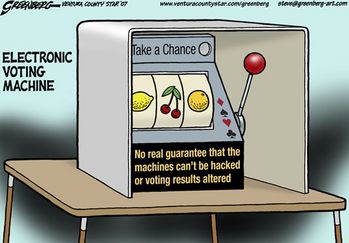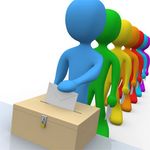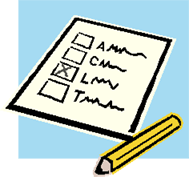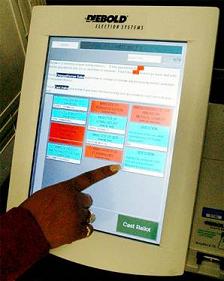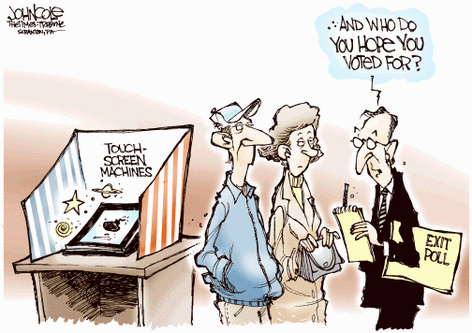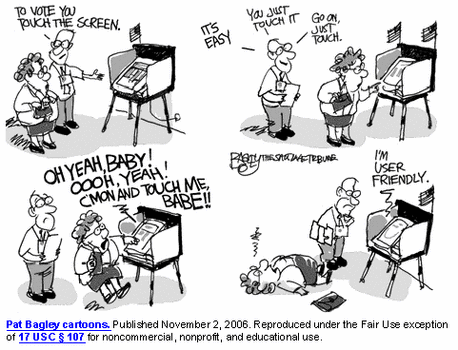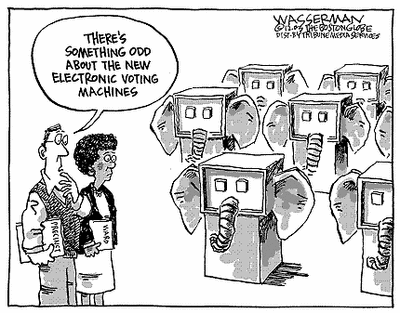F08 CPSC203 T09 GROUP 1
Contents
Team Information
Team Name: Modern Voters
Team Members:
- David Wahl
- Emily Lis
- Luna Helal
- Willie Chan
Technology and Issue
Technology: Electronic Voting
Issue: How Electronic Voting Affects Voter Behavior
Statement: The most recent Canadian federal election held on the 14th of October 2008 had a record low voter turnout of 59.1%. This is a problem across the democratic world, a problem whose solution is increasingly sought through technology, and specifically, Electronic Voting. There are a number of issues associated with Electronic Voting, not the least of which are concerns about security, voter acceptance and comfort (all HCI issues) with any electronic system, and the different levels of convenience offered by various Electronic Voting methods.
Introduction
Have you ever lined for an hour waiting to vote, or maybe drove around in circles trying to find where that polling station was? Or maybe once you found the place, everyone inside had no clue what they were doing, and you got a feeling that if this is what an election was, you didn’t want any part of it. Is it the inconvenience and confusion that drives people away from voting? Particularly the youth of our generation cannot be bothered to be seen at a voting station (because it might be embarrassing and not cool). Our elderly lack the mobility and ability to secure transportation to arrive at their voting stations. The result: the vote does not accurately represent the wishes of our population.
As we approach a century that is more technological and automated, electronic voting has become an attractive alternative to conventional voting, replacing the pen and paper ballot. Though the idea of electronic voting has been around for years, it has been most popular for small scale elections and polls, rather than nationwide. In this report, we will discuss how voting has historically been conducted, its current state, and future possibilities. We will also outline the advantages and disadvantages of electronic voting compared to popular traditional paper ballot methods.
Applications of Voting

Historical Methods
Voting has occurred since the time of the ancient Greeks and continues in many countries today. However, the methods for voting have changed drastically overtime. Voting methods changed as attempts were made to create elections that were more accurate (one man, one vote), private and secure. The earliest types of voting included voting viva voce (by voice) or by having the electorate place balls, clay or metal tokens into a voting container marked for the candidate of their choice (the word "ballot" historically comes from these little balls that were used for voting). Many of these elections included the use of secret ballot. Allowing a voter to vote secretly prevents the voter from being encouraged or coerced to vote a particular way and ensures that the election will more accurately represent the wishes of the electorate. The use of paper ballots has become quite common in modern elections, though their use has been recorded as far back as 139 BCE.By 1892 the U.S. had begun using lever voting machines, as they feared that the paper ballot was still not secure enough (it was easy for candidates to cast multiple ballots if they were allowed to place them in the ballot box themselves, or if an electoral officer were allowed to place ballots in the box, voter privacy would be compromised). These machines required the voter to pull down curtains as they entered (which maintained privacy), pull a lever marked for the candidate of their choice, and pull back the curtains as they left which reset the levers for the next voter. The machine kept a tally of votes for each candidate (though there was no record of who individual voters had actually voted for) but the machine was subject to jamming which resulted in lost votes, and its use was discontinued in 1982. Punch cards have also been used since the late 19th century and involve having the voter punch holes into cards using a supplied punching device. After the voter has marked the punched card, they may place it into a ballot box or have it fed into a machine which will tabulate votes. Some problems associated with punch cards occur when bits of “chad” (paper still attached to the punch card) are left behind, and it cannot be determined whether the voter was attempting to actually punch a hole in the card and something obstructed the creation of a compete hole, or if the voter started to punch a hole but then changed their mind.
Current Methods
More recently, voting has been conducted through e-voting, which refers to casting your ballot via the internet or a touch-tone phone. The most advanced voting technology currently includes marksense/optical scan technology and direct recording electronic (DRE) technology. Marksense/optical technology has been around for a few decades now and works much in the same way that a scantron exam does. The computerized voting machine looks for the darkest mark on a piece of paper after it has been marked by a voter and counts this vote. A direct recording electronic voting machine, on the other hand, requires the voter to push a button or touch a screen in order to submit their vote. A keyboard is attached to the machine so that the voter may write additional comments if they wish. Although these advanced methods are obviously more convenient for the voter, and make voting and counting votes quicker, their efficiency and security remains highly questionable. Despite the conveniences offered by these current technologies, a number of countries that currently conduct elections have refrained from adopting advanced voting technology. In Canada, for example, the federal and provincial elections are still held using a paper ballot, though if a voter is away from home they may vote via a special ballot that is submitted through the mail. There is, however, some electronic voting at the municipal level in Canadian cities.
The Future
Electronic voting is gaining support and acceptance in the world despite major technological failings. The future is shifting from the American style machines with a lever or button for each candidate that require the voter to still get in their car and drive to a polling station, to systems that are internet based and accessible from any internet connection. This technology was used as recently as this October in Halifax. The city awarded a $487,151 contract to “Intelivote”, a firm started by Dartmouth resident Dean Smith, to conduct an internet and telephone vote as a component of the municipal and school board election.
At any time during a three day period voters were able to log on to a website controlled by “Intelivote”. They had to maneuver through a "capture challenge", the familiar security routine of retyping the squiggly letters found in a blurred box, then use their unique PIN and date of birth to identify themselves. Then they were able to vote with the aid of a simple menu for mayor, for councillor, and for school board member.
Canada is thus at the cutting edge of the development of this technology. However variations are used all over the world. The United Kingdom and other European countries have begun initiatives to convert all or part of their voting to electronic balloting, either kiosk or internet based systems. Europe is rushing ahead to deploy computer voting technologies that have serious sociological and technological problems yet to be resolved, such as lack of auditability, and increased opportunities for vote selling, monitoring, coercion, and denial of service attacks. Many of these problems will be ironed out as these systems are field tested, but is that a valid risk to play with democracy?
One day in the not so distant future all voting will be done by computer just as so many other aspects of daily life have been transferred from the tangible to the intangible world of computers. We can now order pizza, watch movies, work, and communicate through a host of social networking sights like Facebook, and Myspace. Electronic voting in the form of kiosks is a reality of today that will become more and more commonplace as the technological problems are resolved. Internet voting is the wave of the future, both here at home in Canada and around the globe.
Advantages of Electronic Voting
Over the past years, electronic voting has been limited to small scale online polls and popularity contests. Although it has existed for many years, electronic voting has not been expanded to a national level. Its advocates now believe with the right security and technologies, electronic voting is becoming a much closer reality. In this day of age, technology has become the ideal replacement for most activities that require accuracy, speed and efficiency.
Benefits of Voting Electronically versus the Paper Ballot include:
Convenience
- more convenient to vote electronically at home, on vacation, or overseas
- poor weather conditions will not affect voter turnout
- do not have to tolerate long lineups and dedicate already scarce time to vote
Accessibility
- multiple languages to support multiculturalism
- custom languages allow minorities to properly navigate and read instructions
- support audio capabilities for people who are visually impaired
- premium on voter accessibility creating greater political participation
Costs
- reduces the cost of hiring human labor
Security and Design
- removes manual work, thus minimizing the human error factor in ballot counting
- ballots can be counted almost instantly and the results updated almost instantly
- operates similar to online banking with audits and encrypted protection
- can be tailored to the specific needs of voters
Environmental
- reduces paper trail and saves trees
- voting at home results in less commuting to and from the polling stations, reducing carbon emissions and gas consumption
Disadvantages of Electronic Voting
Accuracy
- Glitches and problems do not correctly capture the voter’s electronic ballot
- Will people be content with the outcome of a vote that is done electronically?
Security
- Hackers can possibly alter an individual or a group of votes
- Votes can be destroyed (deleted), lost (in cyberspace), or altered (to desired outcome)
- Fraud
- Easier to modify software system’s than hardware systems, making it easier to make these modifications undetectable
- The speed in eletronic voting might risk security
Anonymity
- Is sensitive information (identity) properly protected as information is transmitted online
Scalability
- Stability questions: can the server handle high volumes of traffic without crashing
- How badly will the speed of the system deteriorate on election night
Acceptance
- Which demographics are most likely to accept/reject electronic voting?
- Conventional methods are proven, while new technologies are still risky.
World Use
Electronic voting has been employed in a myriad of countries around the globe at the national, provincial and local levels of government. Specifically in Australia, Belgium, Brazil, Canada, Estonia, the European Union, France, Germany, India, Ireland, Italy, the Netherlands, Norway, Romania, Switzerland and the United Kingdom. However it has not been met with universal success or acceptance. About 85% of electronic voting projects in developing countries have failed in some respect according to the World Bank. Of those, 35% failed completely, and the statistics in the United States and Europe are not much better. The Irish government spent $63 million to test electronic voting technology but an expert group earlier this year recommended against using it, due to doubts about its accuracy and secrecy. The government is still trying to fix the problems so the project can go ahead. Uganda spent $22 million on electronic-voting technology, which did not perform well when elections were held in 2001. In the United Kingdom, an online university project cost $23.5 million, but attracted only 900 students. This suggests that the technology in place is not yet capable of dealing with the demands placed on it, particularly in third world countries. Even where the systems are well managed and operate flawlessly acceptance of the medium for voting has not yet been achieved.
Conclusion
With the development and innovation of technology in recent years at our disposal, it is seemingly incredible that we continue to use paper ballots. E-voting would be the most logical step forward in innovating and re-invigorating the political scene to appeal to voters, particularly those aged 18-24 (who turn out in lower numbers than any other group). Traditional voting methods have lasted centuries, but that may change.
Electronic voting, and e-voting methods have already been adopted by a number of countries. This trend will most likely continue. It is inevitable that electronic voting will make its way to Canada (e-voting has been used in a number of municipal and provincial elections, with Halifax being the most recent province to allow their electorate to vote via e-mail or phone), but it probably won’t improve voter turnout that much. Voter turnout in Canada is low for a number of reasons, but the electorate rarely cites the inconvenience of current voting methods as a reason for not voting. Canadians generally seem happy with our current use of paper ballots. Instead, a negative view of politicians and government, a feeling that voter participation is meaningless, and a lack of interest in politics are generally the top three reasons given for not voting. It will take a lot more than a switch to e-voting and electronic voting methods to remedy these problems for Canada. The fact that there is skepticism surrounding the effectiveness and accuracy of electronic and e-voting (see numerous cartoons) may even hurt our already lacking voter confidence. Despite their setbacks however, electronic and e-voting appear to be the wave of the future, as we are living in an era of technological revolution.
References
Willie
http://igs.berkeley.edu/library/htElectronicVoting2004.html
http://www.associatedcontent.com/article/1131610/electronic_voting_what_is_good_and.html
http://EzineArticles.com/?expert=Ian_Haughton
http://www.aic.gov.au/publications/tandi/ti224.pdf
http://www.parliament.uk/post/pn155.pdf
http://www.ctv.ca/servlet/ArticleNews/story/CTVNews/20061028/voting_technology_061028/20061028/
http://blogs.forbes.com/trailwatch/2008/11/we-should-be-vo.html
http://web.pdx.edu/~caleb/Evoting.html
Emily
http://inventors.about.com/library/weekly/aa111300b.htm
http://www.cs.uiowa.edu/~jones/voting/pictures/
http://www.history.com/encyclopedia.do?articleId=202126
http://dictionary.reference.com/browse/ballot
http://www.halifax.ca/election/evoting.html
http://www.glencoe.com/sec/socialstudies/btt/election_day/history.shtml
http://www.sfu.ca/media-lab/archive/2004/cmns387/TurnoutDecline_2.pdf
http://www.elections.ca/content.asp?section=gen&document=ec90540&dir=bkg&lang=e&textonly=false
http://www.outsidethebeltway.com/archives/2008_voter_turnout_same_as_2004_/
http://thechronicleherald.ca/Editorial/1083146.html
David
http://www.notablesoftware.com/evote.html#UK
http://www.fipr.org/eDemocracy/
http://www.iht.com/articles/ap/2006/10/30/europe/EU_GEN_Netherlands_Voting_Machines.php
http://www.itfacts.biz/85-of-electronic-voting-projects-failed-in-developing-countries/1942
http://news.bbc.co.uk/2/hi/uk_news/politics/2988307.stm
http://www.jasonkitcat.com/h/n/WRITING/evoting/ALL/50/
Luna
http://ap.google.com/article/ALeqM5idDjsuwTrFvBqPemf5MBQr6pdPPAD948DUU03
http://pcworld.co.nz/pcworld/pcw.nsf/feature/52A42C353567DE1ECC2574F7006CEFDA
http://en.wikipedia.org/wiki/Electoral_fraud
http://www.gao.gov/new.items/d04766t.pdf
http://www.opendemocracy.net/media-voting/article_2213.jsp
http://unix.derkeiler.com/Newsgroups/comp.os.vms/2004-04/1422.html
http://www.reason.com/news/show/33863.html
http://www.votersunite.org/info/ElectronicVotingInBrief.pdf
http://redtape.msnbc..com/2008/10/the-headline-fo.html
http://www.usatoday.com/tech/news/techpolicy/evoting/2004-11-04-1000-reports_x.htm
